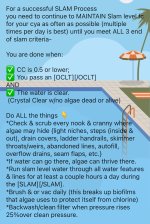Ah. I see.
I was draining to lower limit, then was just filling pool structure all the way to top, let it dilute water in pool, then bypass to waste down to absolute min level was my original thought.
But I see your idea working too. I need a small pump I can hook to water hose for lowering level while filling on opposite side.
Thanks for the idea!!
Pump from the deep end or near the surface?
To determine whether you pump from the deep end of the pool or from near the surface of the pool, depends on your fill and pool water characteristic.
Adding water to the deep end while pumping from a top step or near the surface is recommended if your fill water is much colder (>20F) then the pool water.
Put the pump in the deep end and fill from the shallow end if your fill water is nearly the same temperature as the pool water, you have a saltwater pool, or have very high CH. Put the fill hose in the skimmer, if you have one, in the shallow end. If no skimmer, then use a bucket to put the water hose in and have the top of the bucket above the pool water surface. Be sure to secure the hose to the bucket.
Replacing water in-place process depends on several factors:
[4]
- Pool Water TDS (PWTDS)
- Pool Water Temperature (PWT)
- Fill Water TDS (FWTDS)
- Fill Water Temperature (FWT)
DeltaT = (PWT - PWTDS / 165) - (FWT - FWTDS / 165)
If DeltaT is positive, then you want to fill at the lowest point and extract at the surface and at the greatest distance from the lowest point.
If DeltaT is negative, then you want to extract at the lowest point and fill at the surface and at the greatest distance from the lowest point. <-Preferred as it is easier to do with a drain pump and you can fill inside one of the skimmers.
If |DeltaT| < 5, then there will be a lot of mixing.
Salt is the largest component of TDS. No matter what chlorination method you use, salt is added to the pool water and can be significant after many years. Every 1000 ppm of salt is worth about 6F in temperature difference.
Balance the water flow out and in
Be sure to balance the water out and water in so the pool level stays the same.
When you have the pump you will use, take the effluent hose and fill a 5 gallon bucket while timing it. Calculate your gallons per minute (gpm) from that. Then you can estimate how long to run the process.
It is suggested to exchange 5-10% more water than needed to reduce your CYA/CH/etc to account for errors.
Be sure your pool pump is disabled during this process.
Once started do not stop until complete


